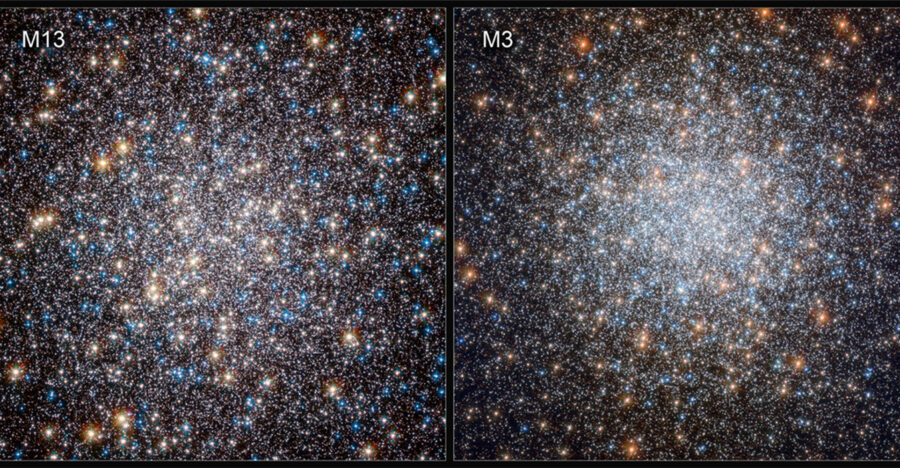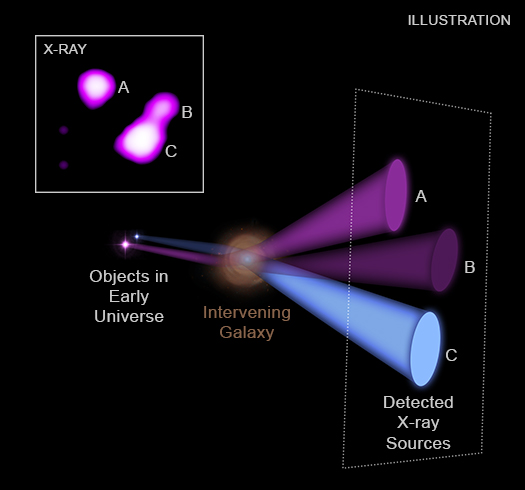This week in astronomy news, we learn that some white dwarfs still burn and image X-rays from black holes almost 12 billion light-years away.
White Dwarfs Still Burn
When stars near the end of their lives, they stop burning. Without nuclear fusion to fend off the press of gravity, most stars will shed their outer layers before collapsing into white dwarfs.
These crushed remnants, no larger than Earth, support themselves against further collapse via the exotic physics of electron degeneracy. But they have no source of energy — or light. They should slowly cool and dim, or so the theory goes.

ESA / NASA / Giampaolo Piotto
Now, ultraviolet Hubble Space Telescope observations of two ancient clusters show that the steady cooling of white dwarfs isn't so steady after all. And that's because some of them do, in fact, still burn.
The globular clusters M3 and M13 are both about 13 billion years old. But despite the clusters' similar age and appearance, Jianxing Chen (University of Bologna, Italy) and colleagues find that M13 has extra bright white dwarfs. That abundance, they show, originates in the cluster's relatively larger number of weensy stars, those with less than about half the Sun's mass. Even after they collapse, these stars will retain an envelope of hydrogen for later burning — in effect, a security blanket of thermonuclear fusion that keeps them warm over the ages.
About 70% of the white dwarfs in M13 are of the slow-burn variety, still fusing hydrogen on their surfaces. The finding upsets the notion of white dwarfs as inert, forever-cooling embers. Read more in the Hubble Space Telescope press release and in Nature Astronomy.
X-ray Magnifying Glass
The Chandra X-ray Observatory has detected 24 X-ray photons that have traveled 12 billion years from a supermassive black hole . In fact, we'd see even less than that if not for an intervening galaxy, which acted as a cosmic magnifying glass and redirected some photons toward Earth.

Illustration: NASA / CXC / M. Weiss; X-ray Image (inset): NASA / CXC / SAO / D. Schwartz et al.
Yet with just two-dozen photons, Daniel Schwartz (Center for Astrophysics, Harvard & Smithsonian) and colleagues have sussed out the nature of the X-ray-emitting system, known as MGB 2016+112. The most likely scenario is that two galaxies have come together some 2 billion years after the Big Bang, and their respective supermassive black holes are in the process of merging. They emit copious amounts of X-rays, many of which are absorbed in swirling gas surrounding the pair. The black holes currently orbit each other 650 light-years apart. Eventually, this hefty duo will unite, radiating gravitational waves in the process.
It's possible that what the astronomers are seeing is actually a single black hole and the very beginning of its thousand-light-year-long jet, rather than a second black hole. Follow-up spectroscopy will help distinguish between these two scenarios.
More information on this system is available in the Chandra press release and the study preprint.
 7
7









Comments
Andrew James
September 9, 2021 at 3:41 am
The arXiv version for the White dwarf paper is here.[1
You must be logged in to post a comment.
Andrew James
September 9, 2021 at 5:51 am
Umm... HST site says: "These results challenge the prevalent view of white dwarfs as inert, slowly cooling burned-out stars where nuclear fusion has stopped. Now, an international group of astronomers has discovered the first evidence that white dwarfs can slow down their rate of aging by burning hydrogen on their surfaces." Seems to me this is too general.
If hydrogen burning is occurring in common-placed DA-type white dwarfs it is happening between the inert isothermal core and the bottom of the ~10 kilometer dense atmosphere. This core diffuses hydrogen slowly into the atmosphere. Simplistically, the core isn't hot or dense enough to fuse the mostly helium, carbon, nitrogen (or neon) at ~20-25 million K, and just behaves like an ideal gas (PV=nrT), radiating s thermal energy. However, at the boundary at bottom of the atmosphere, the pressure, density and temperature suddenly and rapidly drops, but not enough to prevent the hydrogen to fusing into helium. Newly formed white dwarfs likely do this continuously, but as it ages the ignition becomes periodic, then sporadic, then ceases. If it happens, anyway it is relatively short.
This paper argues the hydrogen might be instead dragged into the isothermal core.
For bigger WDs, the bottom of the atmosphere might be a thin helium shell. If I can recall, the thickness and mass of the hydrogen atmospheres affects our estimations of WD mass, WD winds and the cooling rates. Burning hydrogen would then influence these parameters, which is the whole point of the Nature paper I'd think. What worries me they saw the phenomena in M13 but not M3, suggesting this might be dependent on the purity of the hydrogen.
You must be logged in to post a comment.
Andrew James
September 11, 2021 at 5:41 am
Another point dawned on me. If the isothermal core is below ~20-25 million K and hydrogen fuses at ~14 million K at the boundary, then in a zone in just <10 kilometers (roughly to my local horizon) the temperature falls to merely ~8,000 to ~15,000K! The atmospheric convection (technically thermohaline mixing) is impossibly rapid.
IMO, this article deserves a better profiles because, if this is verified, it has significant consequences for our knowledge of stellar evolution. If true, ZZ Cet white dwarfs well become the 'flavour of 2022'!
You must be logged in to post a comment.
Anthony Barreiro
September 10, 2021 at 9:23 pm
I'm curious about those 24 X-ray photons that have been travelling through the universe for 12 billion years. How much were they redshifted by the expansion of the universe during this time? The preprint says the galaxy is at a redshift of 3.273, and the x-rays have "intrinsic 0.5 – 7 keV source frame luminosities". I don't know how to translate keV's to wavelength. I'm assuming they started out with shorter wavelengths and more energy and they've been stretched and cooled since then. It's surprising that they're still x-rays. Any information about this would be appreciated.
You must be logged in to post a comment.
StanR
September 11, 2021 at 4:13 am
A 1 keV photon has a wavelength of 1.24 nm.
Thus a photon of x keV would have a wavelength of 1.24/x nm.
You must be logged in to post a comment.
Andrew James
September 11, 2021 at 4:42 am
0.5 keV=2.4 nm, 7 keV=0.7 nm
At z=3.273 it remains in X-rays.
You must be logged in to post a comment.
Anthony Barreiro
September 11, 2021 at 3:28 pm
Stan and Andrew, thank you both.
X-rays range from 10 nm to 0.1 nm, with shorter wavelengths having higher frequencies and more energy.
I assume that "intrinsic source frame luminosity" means that these x-rays had 0.5 keV to 7 keV luminosity when they were generated by the merging black holes or the single black hole jet. If so, the 7 keV x-ray would have had a wavelength of 0.18 nm, a very high energy x-ray, and would have arrived here with a wavelength of 0.58 nm. The 0.5 keV x-ray would have had a wavelength of 2.48 nm and would have arrived here with a wavelength of 8.11 nm -- a "soft" x-ray, but still an x-ray.
I'm amazed that this light could remain so energetic over such a long trip through spacetime.
You must be logged in to post a comment.
You must be logged in to post a comment.